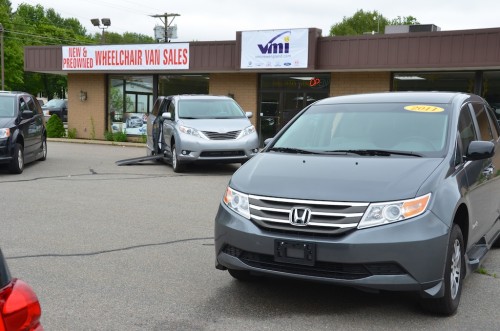Honda’s Mobility Assistance Program
The Honda Customer Mobility Assistance Program is proud to support the mobility needs of drivers and passengers with physical disabilities. Honda will provide a reimbursement of up to $1,000 to each eligible, original retail customer for expenses incurred to purchase and install qualifying adaptive equipment on any eligible purchased or leased Honda vehicle.
Adapting Your Vehicle
Honda suggests that you request a copy of the Department of Transportation brochure “Adapting Motor Vehicles for People with Disabilities.”
The process includes these steps:
- Determine your state’s driver’s license requirements.
- Evaluate your needs – Contact the National Mobility Equipment Dealers Association (NMEDA) for further information.
- Select the right vehicle – Consult with your evaluator, an adaptive installer and your local Honda dealer to determine the best Honda model to meet your needs.
- Choose a qualified mobility equipment installer – Shop around and ask about qualifications, capabilities, experience, warranty coverage and service. Confirm that they are members of NMEDA.
- Obtain training on the use of the new equipment – When this process is complete, follow the guidelines and complete and submit an application for assistance to recover up to $1,000 of the cost of your adaptive equipment and/or conversion.
Program Requirements
General
- Only the original vehicle owner is eligible for reimbursement.
- Modifications must be completed for the original owner or his/her immediate family.
- Only new Honda vehicles retailed or leased in the United States from an authorized Honda dealership.
- Only one reimbursement request per vehicle.
- Lease-vehicle modifications may be subject to written lessor approval. The customer is responsible for determining and satisfying lease-contract requirements.
- Honda will consider reimbursement for modifications made to vehicle after February 1, 2004.
- The written reimbursement request must be received within 6 months of the adaptive equipment installation.
Adaptations, Modifications or Equipment Installation
- Qualifying adaptive equipment or conversion is defined as: alterations or adaptive-equipment installation that provides to the disabled user convenient access and/or the ability to drive the vehicle.
- Adaptive equipment installation must have taken place within the time and mileage limits of the New Vehicle Limited Warranty.
- Alterations or adaptive equipment installation requires a prescription or medical documentation to be considered for reimbursement.
- Reimbursement requests (invoices) will be compared against the National Highway Traffic Safety Administration (NHTSA) Web site to verify that the alterer or repair business (individual, partnership or corporation) is registered with NHTSA and that the modification(s) are on the list of NHTSA exemptions.
- If all conditions are met, Honda will provide up to a $1,000 cash reimbursement. Honda will be the secondary coverage in the case of two or more reimbursement sources.
Exceptions
- Wheelchair or scooter hoists or ramps do not require a prescription, medical documentation or NHTSA exemption verification and NHTSA business registration for reimbursement consideration.
- Modifications that DO NOT make inoperative any part of a device or element of design that has been installed on or in a motor vehicle in compliance with a Federal Motor Vehicle Safety Standard will not require NHTSA exemption verification and NHTSA business registration for reimbursement consideration.
- *A reimbursement made by another source, such as medical insurance, will be subtracted from the customer’s original total expense. (Example: Total expense $5,000, Insurance reimbursement $4,000, Customer expense, $1,000. The customer expense of $1,000 will be reviewed and considered for a maximum of $1,000 reimbursement.)
Important Customer Information
- The selection of an equipment manufacturer and installer is solely the customer’s responsibility (Honda does not endorse any company or supplier involved in adaptive equipment. Mobility warranty, installation warranty and related liabilities are not the responsibility of Honda).
- The reimbursement application form must be completed in its entirety and signed by the customer. It should be mailed along with a copy of all required supporting documentation. (See checklist on application).
Click HERE For the Honda Mobility Assistance Brochure


